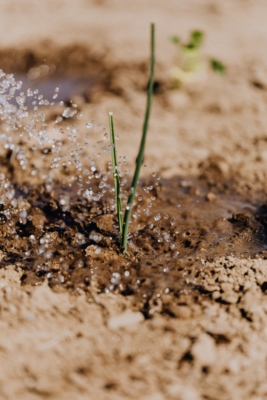The best time to seed or overseed your lawn is late August or early September.
This is when most weeds are done germinating, temperatures are cooler (70 – 75 degrees is ideal) and there is abundant rainfall.
STEPS
The key to a good lawn is 4-6 inches of good soil. If your soil is clay, add sand/peat. If your soil is sandy, add a peat moss/top soil mix such as Briggs Complete Planting Mix. Till the soil amendments into the top six inches of existing soil.
To seed over an existing stand of grass, you need to loosen the surface of the soil as much as you can without damaging the existing grass. This can be done with a steel tine rake or a dethatching attachment to your mower. You may get a stand of grass if you simply spread the seed over bare ground, but it will have to struggle to develop an adequate root system and will be thinner and less resistant to disease and winter damage.
Add powdered or pelletized lime at a rate of 40-50 pounds per 1000 square feet. Then apply a good quality grass seed such as Briggs New England Mix or Briggs Country Shade Mix at 6 lbs./1000 sq. ft. If you are overseeding, apply at 3 lbs./1000 sq. ft.
Apply fertilizer like Scotts Starter Fertilizer or Greenview Green Start to help develop root systems. If seeding in spring, apply starter fertilizer with crabgrass control.
Water lightly (keep moist, not wet, to avoid puddles). Depending on weather conditions, you may have to water 3-4 times daily.
Aeration/Overseeding: Depending on soil conditions, your lawn may need to be aerated annually. Early September is the best time. Apply seed after aerating.
SPRING SEEDING
The best time to seed a lawn is in the late summer/early fall. Seeding in the spring can be a challenge, however there are circumstances that warrant it:
- Thin turf due to winter damage
- Poor turf density due to poor recovery from the previous year’s problems (grub damage, drought damage, etc.)
For most successful spring seeding, you must:
- Seed as early in the season as possible to maximize the success of turf grass over crabgrass. Dormant seeding or early April seeding is preferred
- Maximize seed-soil contact through good soil preparation. Irrigate often as soon as temperatures favor germination (soil temperatures above 55°F)
- Irrigate often as soon as temperatures favor germination (soil temperatures above 55 degrees F). As root systems develop, gradually reduce frequency but increase duration of irrigation. Continue irrigation throughout the summer until an adequate root system is established
- Control weeds in the lawn because spring-germinating weeds will outcompete the desirable turf grass and may kill it.

CARE AFTER SEEDING YOUR NEW LAWN
Mowing – The new lawn should be mowed as soon as the mower can get a “bite” set 2 inches high. A sharp blade cuts the grass without tearing. If the clippings clump and bunch, rake and remove them.
Weeds – Clip any broadleaf weeds at a 2 inch height as you would the grass. This allows the sun and air to reach the tender blades of grass around them. Pulling weeds disturbs the soil and will kill many new grass plants. After three mowings, your lawn should be able to withstand most additional weed or feed treatments.
SELECT THE RIGHT SEED FOR THE RIGHT LOCATION
Full sun (8 hours or more daily): Bluegrass, Perennial Rye, Fall Fescues (Briggs Duragreen Mix)
Part sun/shade (6-8 hours daily): Mixed varieties (Briggs New England Estate)
Shade (4-6 hours daily): Red Fescues, Creeping Fescues (Briggs Country Shade Mix)
If the area receives less than 4 hours of sun daily, even the best shade mix will struggle, needing much maintenance annually, often with poor results. Consider a shade ground cover such as Pachysandra, Myrtle or Ivy in these areas.
GRASS TYPES
Perennial Ryegrass – An ideal grass where rapid establishment is necessary. Uses include athletic fields, golf course fairways and in lawn mixtures with Kentucky bluegrass. Contains Endophytes *
Tall Fescues – Recommended for lawns, athletic fields and low-maintenance areas. The newer turf-type cultivars are much more attractive than their predecessors, although compared to Kentucky bluegrass, they still have a much coarser leaf texture and more rapid vertical growth rate.
Fine Fescues – These grasses perform well under low moisture and low maintenance (fertilization, mowing) and should be maintained as such. Most cultivars perform well in shade. Fine fescues are best used in mixtures with shade-tolerant bluegrasses.
Kentucky Bluegrass – Recommended for home and general lawn areas, athletic fields and golf course roughs. These grasses perform well under a wide range of conditions. Most cultivars will do best in full sun. Use a blend of at least 3 varieties when using Kentucky bluegrass.
*Endophytes – Symbiotic fungi that live within the grass plants. Endophytic grasses have shown resistance to surface feeding insects.